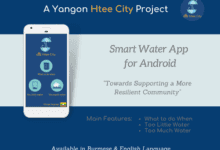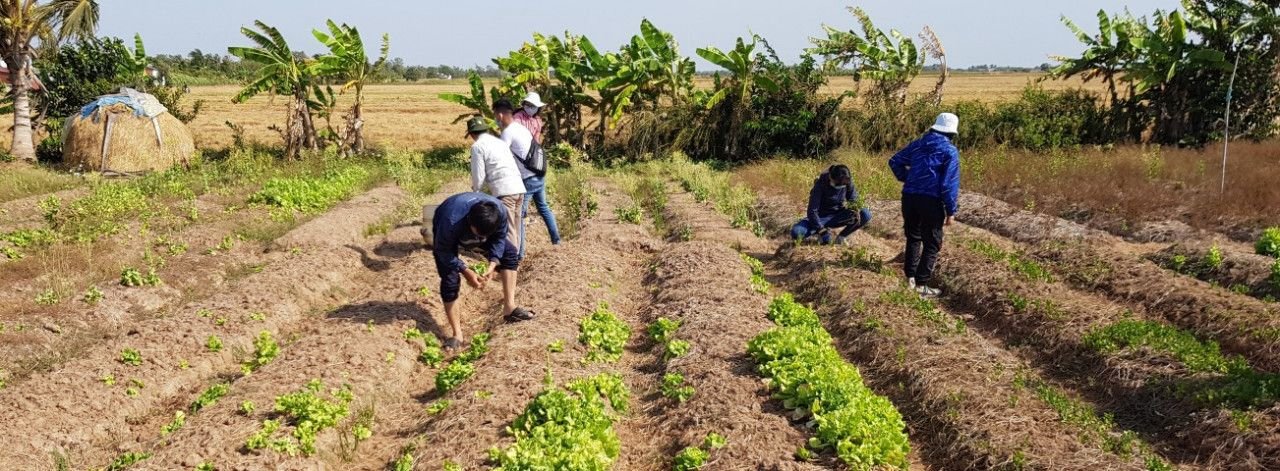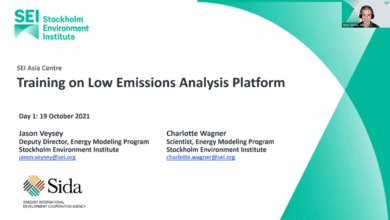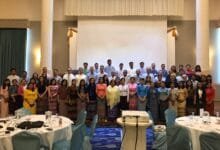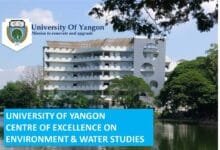
Have you already heard of U Myint Thein, the one who has full of knowledge and experiences in the groundwater sector as well as a writer and also a winner of Myanmar National Literacy Award 2018?
This week we arrange an interview section with him and in this article, he shared about his career life starting from graduation to the present time and some of his perspectives and suggestions upon the condition of groundwater in Myanmar though he is living with HeartMate III (LVAD) because of heart failure since 2017. So, let’s dive deeper and I am sure that this article makes you knowledgeable about the conditions of groundwater and the needs to improve the groundwater sector in Myanmar.
Q: Could you tell me the brief introduction of your career life long journey?
A: When it comes to my career, I have to start from the moment I graduate. In 1974, I graduated a bachelor degree in Geology from Rangoon University (now, the University of Yangon). After my graduation, I first worked as an assistant engineering geologist in Irrigation Department, Burma (Now- Ministry of Agriculture, Livestock and Irrigation (MOALI)) till 1980. I had faced and passed many challenges to reach such a successful career life such as when I first dug a well, the water did not come out.
Starting from 1981, I started working as a hydro-geologist in Rural Water Supply Division, Ministry of Agriculture and participated in a Burma Village Water Supply Project (BVWSP) (ကျေးရွာရေရရှိရေးစီမံကိန်း). This project specialized and focused only on supplying groundwater to all around Myanmar, especially in three divisions of the dry zone such as Mandalay, Magway and Sagaing divisions. We dug many wells in those water scarcity areas including deep wells, shallow wells, etc., and we supplied water from wells with high yield to the nearest villages in the name of Village Group Water Supply Project as an additional project. BVWSP included dwelling, exploration, hydrological investigations and researches, technological know-how, etc.
Photo source: Sayar Nanda Min Lain (from Rural Water Supply Station, Sagaing Division, Late 1986)
Foreign water drilling trainer and trainees in Rural Water Supply Project
Photo source: Sayar Nanda Min Lain (from Rural Water Supply Station, Sagaing Division, Late 1986) Groundwater Exploration Subject on post graduate diploma course in Delft, 1987.
Moreover, Myanmar had been selected as the one for the First Water Decade in Southeast Asia at that time, and so the project became a grant program with the support of many organizations such as United Nations International Children’s Emergency Fund (UNICEF), World Health Organization (WHO), the Australian Development Assistance Bureau (ADAB) and the Netherlands with the 100 million budgets for 10 years. With that funding, we dug over 3000 wells in 3100 villages in the dry zone together with many experts such as hydrogeologists, civil engineers, mechanical engineers, technicians (dwellers) from Government Technical Institute (GTI). Besides, all the people involved in that project got the foreign experiences by having a study tour, scholar tour, job training and minimum workshop training by travelling to England, Germany, Netherlands and Australia and so on. I got a scholarship from The Netherlands Government to study Groundwater Exploration Subject on post graduate diploma course in Delft.
Furthermore, for the areas where groundwater cannot extract easily like Chin Mountain region, we provided Pipe Water Supply called “Spring water supply” which is the process of uploading the water from cool mountain spring by gravity and several pipe joining. (စိမ့်စမ်းရေသွယ်လုပ်ငန်း). That kind of project can find in some regions of India such as Arthan and Manipura. We had firstly carried out this kind of project in Tedim (Flam) Township.
Afterwards, from 1993 to 1998, I went out to Singapore and worked as an Engineering Geologist at a Construction Company. There, I had done many geotechnical surveys about the groundwater control system in constructions all around in Southeast Asia. Then in 1998, I came back to Myanmar due to the economic crisis in Singapore.
In Myanmar, I established a GEOASIA Groundwater & Wells and Ground Engineering Consultancy and Services company and worked as a Principle consultant from 1998 to 2003. I did many consultancies and groundwater projects for many factories such as Tiger beer factory, ABC factory, etc.., from 1998 to 2003 (6 years) in Myanmar. On the other hand, I did as a co-supervisor cooperated with my groundwater guru Late U Ngwe Thein for PhD student form Geology Department of Rangoon Institute of Technology (RIT) in 2001.
UMyint Thein in one job site (Tiger Beer Factory, year 2000)
Tiger Beer Factory, Year 2000: discharge water 10000gal / hr.
I started participating as an advisory group member of National Water Resources Committee (NWRC) in groundwater sector since 2016 and also as a visiting lecturer at Myanmar, Geosciences Society Training Centre for Junior Geologists in Yangon from 2016 to 2017.
Again in 2004, I went back to Singapore and worked as a Senior Geotechnical Engineer at construction industries and then retired in end 2015. On the other hand, I have been writing numerous groundwater-related articles based on my experiences and knowledge since 2012. At present, I am supervising and advising to groundwater association/ individual/ students who did thesis paper for their higher degree such as M.Sc. and PhD and writing many articles including Groundwater Law (Draft) for NWRC and National Housing Board Department (Now no more) and books: some of them have already been published. Besides, I am still working as a freelancer consultant in Groundwater and Well industry for dwellers, drillers and students. From 2019, I became a member of the Board of Director of Myanmar American Science and Technology Association Alumni, New York, US (MASTA). MASTA starts working for technical knowhow with Academic sectors and private communities from Myanmar. I am still standing as an advisory group member in groundwater sector of National Water Resources Committee, Myanmar.
 Groundwater and water affairs (Myanmar version)
Groundwater and water affairs (Myanmar version)
List of articles and books written by U Myint Thein
- Groundwater and water affairs (Myanmar version) (3rd times Printed) – မြေအောက်ရေ နှင့် ရေအရေးစာစုများ (မြန်မာဘာသာဖြင့် – တတိယအကြိမ်ပုံနှိပ်ထုတ်ဝေပြီး)
- Water Resources Myanmar (English version) – Under process for proofreader by Sapay Beik Hman
- Our water our future and Groundwater some (Myanmar version) – under the process to print by Seik Ku Cho Cho Press, Yangon – ဒို့ရေ၊ ဒို့အနာဂတ် နှင့် မြေအောက်ရေအကြောင်းတစေ့တစောင်း(မြန်မာဘာသာဖြင့်)
- A Primer on Groundwater Technology and Water Wells Drilling Notes (Myanmar version) – under the process of writing and plan to print in July-August 2020 – အခြေခံမြေအောက်ရေပညာနှင့် စက်ရေတွင်းတူးမှတ်စု (မြန်မာဘာသာဖြင့်)
 Myanmar National Literacy Award 2018
Myanmar National Literacy Award 2018  Hydrogeology of the Dry Zone – Central Myanmar
Hydrogeology of the Dry Zone – Central Myanmar 
1????1
Hydrogeology of the Dry Zone — Central Myanmar – Myanmar Water Portal
This report has been prepared by Dr Len Drury, Aqua Rock Konsultants, with assistance from the Groundwater Division, Irrigation and Water Utilization Management Department (IWUMD) of the Ministry of Agriculture, Livestock and Irrigation (MOALI). https://www.myanmarwaterportal.com/repository/580-hydrogeology-of-the-dry-zone-%E2%80%94-central-myanmar.html
Q: What are your perspectives upon the condition of groundwater in different regions of Myanmar?
Could you share your perspectives on specific regions such as central Dry zone, Thanintharyi coastal region and delta region?
A: Central Dry Zone
At the moment when it comes to Myanmar’s underground water, I have to talk only bad perspectives because groundwater in Myanmar is getting worse in quality as well as lower in quantity. Especially drought in the dry zone more used to be happening in summer. Due to the growing population, contamination and climate change, the rate of discharge becomes higher but recharge by rainfall becomes lower. These are the main reasons why the groundwater level is decreasing nowadays.
As the groundwater subsides, the water quality also decreases. Actually, water under the ground stays between the rocks, soil structure. By flowing of water through them, the minerals in the soil and rock layers are melting into the water. Therefore, minerals dissolved amount are higher and minerals dissolved water stored longer time in aquifer and then, the concentration of the minerals will be higher in groundwater. For instance, 100 mg minerals in 1000-gallons water have better quality than 1000 mg in 1000 gallons water. Thus, I can say that the decline in groundwater quality across Myanmar is the main consequence of the decline in groundwater level due to over pumping.
Another example is that in some townships between Chindwin River and Ayeyarwady River such as Kawlin, Wuntho and Upper Shwebo and up to Myitkyina, water quality becomes seriously degrading. Too much production of gold and other associate minerals from gold mine industries and too much cutting trees are the major factors of the topography changes, hydrological and hydrogeological changes in those areas and they endanger to the natural environment. For now, peoples from the Dry Zone and Coastal Region mostly suffer from not getting enough water and even the extracted water is contaminated.
Tanintharyi Coastal Region
Normally, the soil type of coastal region is very soft in the upper layer and also, on the other hand, there is erosion by the Rivers. Moreover, deforestation is also increasing. Therefore surface runoff passing through the mountain washes out of the upper soil layer making the mountain steeper and decreasing the slope stability (i.e: Slope stability become weak). The occurrence of a landslide in Paung Township in last year was an obvious example.In fact, not only sliding of the upper surface but also the lower soil becomes a curvature and collapsing. Splitting of these unforeseen soils covers the dug wells and shallow tube wells. Those are the main causes of decreasing groundwater quality.
One more example is that water scarcity in Dawei Township is getting higher these days. Normally, Dawei Township gets the discharge from the Daw Na mountain range but due to the deforestation and higher soil erosion, the rate of the surface runoff increases together with high contamination. Besides, the infiltration rate becomes lower because water bearing layers are not thick and due to the urbanization. The host rocks are impervious and shallow depth. Thus, the groundwater level becomes lesser than before. People don’t know about it and even though they dwell very deep, the outcome is still very low with poor water quality and facing hard rock drilling.
Besides, the intrusion of seawater is also becoming a threat to groundwater. At first, the thickness of fresh water is enough to press the coming intrusion of seawater with its sufficient hydraulic pressure. However, the groundwater column becomes lower with the lower recharge and so that it is easy for seawater to replace with fresh water because the density of seawater is 1.025 and fresh water is 1.00 and so seawater 0.025 times denser than the freshwater. This is also the reason that the water becomes easily salty. Although salt water can treat, it is very costly to do it. Therefore, we need more than two generations to preserve the quality of groundwater naturally. The best way to control salt water intrusion is not to discharge more than recharge.
Ayeyarwaddy Delta Region
The issue in groundwater in Delta Region is only the quality decreasing. Because of the sea level rising and having the high tide condition in the delta region, seawater usually overwhelms the areas near the coast and arrives into the land by heavy winds during the storm. After the storm, even though the tide and the overwhelming water go back to the ocean, 1/3 of the seawater is still left over the land and this can cause not only the contamination of surface water through flowing into the rivers, streams and lakes and also the contamination of groundwater through infiltration into the ground and soil becomes salty soil that is difficult to cultivate. In this way, groundwater contamination is increasing gradually in the delta region.
Q: What will be the precautions and preparations needed to preserve the groundwater?
A: Of course, Myanmar still needs some precautions and preparations to preserve groundwater. I will share some of the most important things. The first one is,
To set up groundwater law and enforcement
In November 2019, the parliament approved a draft version of the groundwater law and finalized and published in some newspapers but it was still pending because some organizations objected. The law must have TWO key points; one is Groundwater Management and other is Groundwater Basin Management. Those have different ambition. Not only having law and enforcement and also following up the rules are the most important factors in preserving the groundwater.
Raising Education and Knowledge Sharing Campaign to the Community
As for the second thing, I suggest holding educational and knowledge sharing campaigns to educate people to have an awareness of water usage. They also need to know about the law and guidelines. Besides, educational seminars should be conducted not only for adults and also for the children. Only then, the children will have water / groundwater knowledge since from an early age and they can become excellent leaders later.
Applying Published Articles of the Experts in Universities
Moreover, there are many articles and books published by professionals. So, many organizations such as the university, city development committee, NGOs should apply those books for sharing and developing knowledge within their organization. Especially, the seminars by the professionals like giving small lectures should be held in universities to get external knowledge for the students. In this way, they can be more aware and educated and get good cohesive access between Academic and industries.
Besides, there is one more way to preserve groundwater. Firstly, we have to use surface water if it is in the usable condition. Only when the surface water quality and quantity decrease, groundwater must be used. Generally, people used to follow the easy way. They dig a tube well because it has more accessibility. In another country like America, digging a well has to follow many steps to get permission. First, the authorized person from groundwater management, groundwater basin management comes and takes the ground check and then gives guidelines how much size and depth is allowed to dig and how much water is allowed to discharge. In Myanmar, the later generations should try to get better systematic groundwater management and groundwater basin management with the right law, rules, disciplines and right human resources.
Additionally, we need to have an awareness of climate change. Nowadays, the climate is changing and it is getting the worst condition in Southeast Asia. Sea level is rising year by year with centimetre, not even with millimetre and therefore, sea level dispersion over the low land is getting wider and longer.
To sum up, all of the above methods are a long way to happen. Therefore, as for the current control, the human factor is the most important. Increasing water storage capacity can be done only reducing the water usage without necessarily but reforestation also.
Q: What are the ways to recharge the groundwater?
A: There are many ways to increase the groundwater recharge such as having law, systematic rules and guidelines together with the strict enforcement for the citizens and reforestation etc. For example, installing a water meter and setting up a suitable amount of water tax can control the overuse of water without necessary. To be more specific, setting up the normal rate for the basic need of water up to 250 gallons per day and when the water usage is over the basic need, increasing the tax to a certain amount. In this way, people may have awareness upon water usage. Also, as well as regular maintenance of pipeline is needed in surface water distribution, qualified tube well inspectors are also needed in groundwater industry.
Besides, I would like to suggest everyone have a separate place to wash the clothes which should be a few far away from the tube well for not penetrating of soap water into the soil to prevent the pollution and contamination to the well. Besides, I want to remind not to make gardening near the well. By gardening near the well, the use of fertilizers including chemicals will reach the saturated soil and then to the groundwater. Finally, groundwater can be polluted and contaminated.
Q: You mentioned groundwater basin management and groundwater management earlier. So, what are the differences between them?
A: Groundwater Basin Management includes technological know-how such as how to control technically your basin, how to manage to reduce the remediation, deviation and how to manage to increase the storage capacity, i.e. groundwater budget like banking account. It also involves groundwater hydraulics principles to determine the life expectancy of groundwater well, its discharge rate, discharge period and so on.
Unlike the Groundwater Basin Management, Groundwater Management includes law and disciplines for the user such as dwellers, engineers, consultants, and also involves administrators’ guidelines for construction projects. Giving guidelines for how many lifetimes of the tube well is allowed, how much water is allowed to discharge per hour, how much the cost of water meter per hour, etc. These all activities by dwellers and contractors, drillers recorded in database (data bank) of state and division and finally Nationwide will be perfect.
I wrote the differences between them in detail in one of my published books.
Q: How do you suggest to the organizations in the water sector and future generations?
A: Many organizations in Myanmar especially nongovernmental organizations (NGOs) are doing their movement separately depending only on their donor country. In my opinion, this cannot make a significant change for Myanmar. I strongly suggest having negotiations between each organization and having a link between them. Besides, they also should have close contact and collaborate with the university to do research and improve capacity building.
Moreover, I welcome and appreciate all the ones who are willing and have a passion in the water sector and if there is something need to know, you all can come and ask me anytime through my email address which is ” Myint Thein Groundwater & Wells Consultant This email address is being protected from spambots. You need JavaScript enabled to view it.. I wish future generations have and get the right study and people or reference. Access and trends must be true. I wish the emergence of many comprehensive water engineers who know the surface water and Hydrogeologists/groundwater Specialists know the groundwater depending on the origin, occurrence, groundwater hydraulic and concept.
This article is written by Thandar, a final year student of Yangon Technological University.


